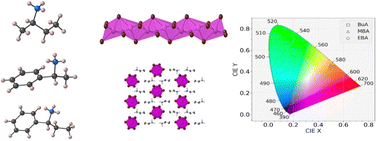Using chiral ammonium cations to modulate the structure of 1D hybrid lead bromide perovskites for linearly polarized broadband light emission at room temperature†
Abstract
We report on a series of low dimensional 1D enantiomerically pure and racemic lead bromide perovskite compounds of the formula BuA-PbBr3, MBA-PbBr3 and EBA-PbBr3 (BuA, cation derived from 2-Butylamine, MBA from Methylbenzylamine and EBA from α-Ethylbenzylamine) incorporating monovalent chiral ammonium derivative cations. A series of 6 enantiomerically pure compounds is described. The compounds are fully characterized from a structural point of view using X-Ray diffraction on single crystals and XRPD. Their photoluminescence emission properties have been carefully investigated. The use of cations of different sizes allows tuning the distances between the inorganic one-dimensional (1D) chains. All compounds show broadband below-bandgap emission, attributed to Self-Trapped Exciton (STE) recombination. The photoluminescence is characterized by a significant degree of linear polarization at room temperature, which can be explained by the structural anisotropy of the transition dipole moments and quantum confinement of the excitons in the 1D material. Our results indicate that the described compounds are of high interest for linearly-polarized broadband light-emitting devices and demonstrate the possibility of engineering the crystalline structure by the appropriate choice of the organic cation.



 Please wait while we load your content...
Please wait while we load your content...